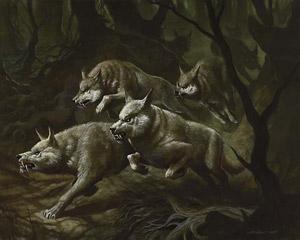By Alan McCoy from Dungeons & Dragons: Fundamentals
How to build challenging encounters against a Wolf / Dire Wolf Pack
First and foremost: I want to state this to any and all game designers that utilize these fierce and majestic beasts as semi-tame guard animals. Please use large guard dogs instead! Wolves are not wolves unless they’re in the wild. Wolves were the Alpha predator of most of Western Europe prior to and even quite a bit after the invention of reliable firearms, they are very formidable predators. Little wonder that for centuries the howl of wolves has been considered terrifying.
This has been prepared utilizing only the 5E Core Rules. While individual wolves are commonly used as low level beasts, they are rarely if ever encountered in packs of less than six. I almost never use them in less than packs of twelve. For the record, while groups of as few as three have been found, the large hunting packs in Yellowstone consist of about twenty-five. One pack has been spotted with thirty-six.
Step 1) Let’s review what we know about the Wolf
They have Keen Hearing and Sense of Smell; the Wolf has Advantage on Wisdom (Perception) Checks that rely on hearing or smell. A wolf pack will be drawn in by the scent and sound of prey animals. If the prey has been injured or has been exposed to blood or gore, they wolves will consider them even more inviting targets as injury = weak and weak = food.
Wolves are hard to surprise, with a passive perception of 13. ‘Hiding alone’ won’t help, since they can still hear and smell you.
Pack tactics give the wolf advantage on Attack rolls against a creature if at least one of the wolf’s allies is within 5 feet of the creature and the ally isn’t Incapacitated.
Wolves are Nimble (Dex 15), strong (Str 12), tough (Con 12) and Cunning (Wis 12).
Wolves try to knock prey down. Creatures hit by it’s bite must make a DC 11 Strength Check or be knocked prone.
Wolves are fast having a natural movement speed of 40.
Step 2) Determine the probable Strategy
Wolf strategy is determined by the Alpha Male and Alpha Female of the pack, they consider humanity (Any PC) as prey, and will attempt to ‘spook the herd’, and isolate what they perceive to be a weak member.
The goal is to drive off the main force allowing them to concentrate their attacks on a single individual. Most of the time, the Alphas have chosen their target prior to their attack.
Step 3) Determine Tactics
Wolves attack by the direction of their Alphas, these wily and mature wolves have years of hunting experience and know how to effectively bring down prey.
They will control the overall attacks of their pack to make sure that the wolves do not get in each other’s way. It is a good idea to roll individual initiative for each pair of wolves.
Wolf pairs with the same initiative will attack different targets.The pack will begin by circling the prey, and feinting attacks. Run in twenty feet, bite attack and then retreat twenty feet. In this stage, if they make a successful attack they will attempt to knock prone, but will withdraw.
The wolves are attempting to intimidate with their initial attacks on the party. While this has little to no effect on Player Characters, it will probably greatly disturb and potentially spook any pack animals or mounts possessed by them.
This is actually very lucky for the Party, since the packs goal is food, they will probably give chase to any animal that breaks away from the party, rather than continuing to harass the group.
Once the Alphas signal to begin the attack in earnest however, the tactics will change. While some wolves will continue to corral the party, a large section will begin to make rush attacks on one side of the party. Instinct will direct them to attack weaker party members instead of highly armored strong individuals.
The pairs will attack in pairs. Run in twenty feet, bite and then retreating if they miss.Meanwhile, the wolves to the front and sides of the prey will ‘DODGE’ and dance, harassing and howling, but not seriously attacking.
Facts to Remember:
Wolves have pack tactics and the advantage on their attacks when within five feet of an ally.
Wolves are cunning foes and will minimize the attacks of opportunity made against them by varying the angle of attack. In any case, each PC has only one reaction, and therefore only one attack of opportunity.If an attack succeeds, then next pair of wolves and subsequent wolves will immediately attack the down target. A size S target can be attacked by 4, a size M can be attacked by 6 and a size L can be attacked by 8 individual wolves.The rest of the pack will attempt to drive away the group of prey.If a wolf is injured, the pairs will shift and the injured wolf will join the harassing wolves to the front and sides, while one of the harassers will join the attack pair.The attack ends when the group has successfully obtained a meal, or if the pack has been significantly injured. I would consider over half of the pack hurt or over a quarter of the pack killed to be enough to cause a retreat.
